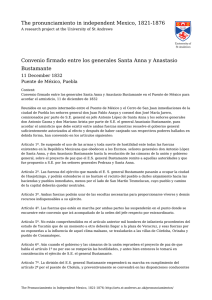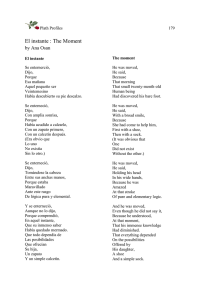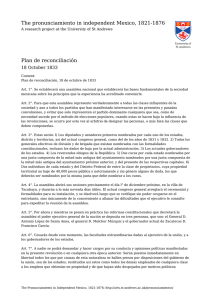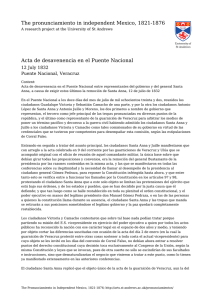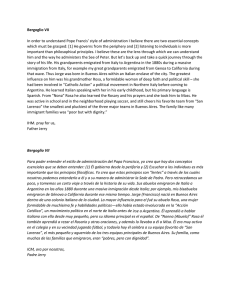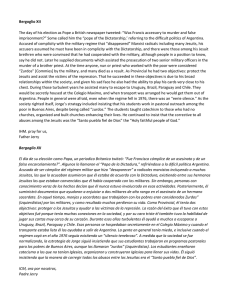Armisticio firmado en la Hacienda de los Morales
Anuncio
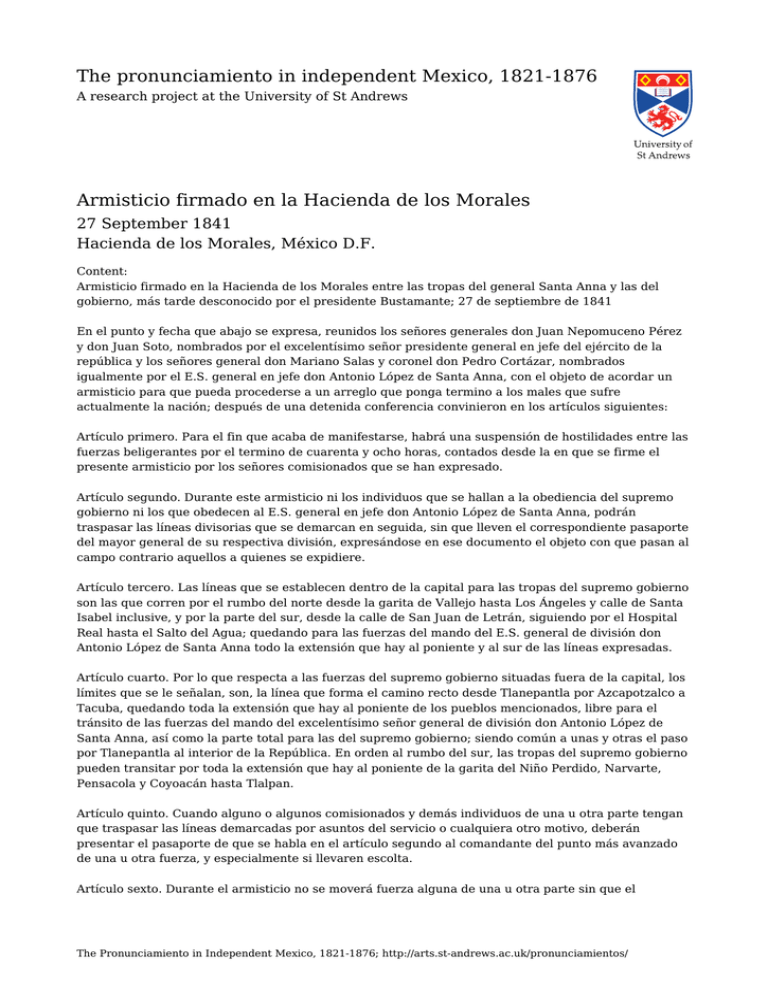
The pronunciamiento in independent Mexico, 1821-1876 A research project at the University of St Andrews Armisticio firmado en la Hacienda de los Morales 27 September 1841 Hacienda de los Morales, México D.F. Content: Armisticio firmado en la Hacienda de los Morales entre las tropas del general Santa Anna y las del gobierno, más tarde desconocido por el presidente Bustamante; 27 de septiembre de 1841 En el punto y fecha que abajo se expresa, reunidos los señores generales don Juan Nepomuceno Pérez y don Juan Soto, nombrados por el excelentísimo señor presidente general en jefe del ejército de la república y los señores general don Mariano Salas y coronel don Pedro Cortázar, nombrados igualmente por el E.S. general en jefe don Antonio López de Santa Anna, con el objeto de acordar un armisticio para que pueda procederse a un arreglo que ponga termino a los males que sufre actualmente la nación; después de una detenida conferencia convinieron en los artículos siguientes: Artículo primero. Para el fin que acaba de manifestarse, habrá una suspensión de hostilidades entre las fuerzas beligerantes por el termino de cuarenta y ocho horas, contados desde la en que se firme el presente armisticio por los señores comisionados que se han expresado. Artículo segundo. Durante este armisticio ni los individuos que se hallan a la obediencia del supremo gobierno ni los que obedecen al E.S. general en jefe don Antonio López de Santa Anna, podrán traspasar las líneas divisorias que se demarcan en seguida, sin que lleven el correspondiente pasaporte del mayor general de su respectiva división, expresándose en ese documento el objeto con que pasan al campo contrario aquellos a quienes se expidiere. Artículo tercero. Las líneas que se establecen dentro de la capital para las tropas del supremo gobierno son las que corren por el rumbo del norte desde la garita de Vallejo hasta Los Ángeles y calle de Santa Isabel inclusive, y por la parte del sur, desde la calle de San Juan de Letrán, siguiendo por el Hospital Real hasta el Salto del Agua; quedando para las fuerzas del mando del E.S. general de división don Antonio López de Santa Anna todo la extensión que hay al poniente y al sur de las líneas expresadas. Artículo cuarto. Por lo que respecta a las fuerzas del supremo gobierno situadas fuera de la capital, los límites que se le señalan, son, la línea que forma el camino recto desde Tlanepantla por Azcapotzalco a Tacuba, quedando toda la extensión que hay al poniente de los pueblos mencionados, libre para el tránsito de las fuerzas del mando del excelentísimo señor general de división don Antonio López de Santa Anna, así como la parte total para las del supremo gobierno; siendo común a unas y otras el paso por Tlanepantla al interior de la República. En orden al rumbo del sur, las tropas del supremo gobierno pueden transitar por toda la extensión que hay al poniente de la garita del Niño Perdido, Narvarte, Pensacola y Coyoacán hasta Tlalpan. Artículo quinto. Cuando alguno o algunos comisionados y demás individuos de una u otra parte tengan que traspasar las líneas demarcadas por asuntos del servicio o cualquiera otro motivo, deberán presentar el pasaporte de que se habla en el artículo segundo al comandante del punto más avanzado de una u otra fuerza, y especialmente si llevaren escolta. Artículo sexto. Durante el armisticio no se moverá fuerza alguna de una u otra parte sin que el The Pronunciamiento in Independent Mexico, 1821-1876; http://arts.st-andrews.ac.uk/pronunciamientos/ excelentísimo señor general en jefe de la que lo verifique, dé conocimiento de ello al de la fuerza contraria. Artículo séptimo. Tampoco podrá emprenderse, durante el propio armisticio de una u otra parte, ninguna obra de fortificación ni proseguirse las que no se hallen concluidas. Y comprometiéndose solemnemente los comisionados que se han expresado al más exacto y puntual cumplimiento de todos y cada uno de los artículos que preceden, firmaron el presente armisticio por duplicado en la Hacienda de los Morales a los veintisiete días del mes de septiembre de 1841, a las once de la noche. Juan Nepomuceno Pérez, Juan Soto, J. Mariano de Salas, Pedro Cortázar. Ratificó este armisticio, Antonio López de Santa Anna Context: August 1841 saw the advent of what has been described as the Triangular Revolt. The first player to move into action was the profoundly reactionary, elitist and hard-drinking General Mariano Paredes y Arrillaga, who launched the pronunciamiento of Guadalajara of 8 August. In his plan, Paredes y Arrillaga called for the creation of a new congress whose sole purpose would be to reform the 1836 charter. He also demanded that the Supreme Conservative Power name one individual who would be given extraordinary powers to oversee the peaceful transition from the current government to the new one. Much to President Anastasio Bustamante’s horror, his faithful aide, General Valencia, who had played such an important role in quelling José Urrea and Valentín Gómez Farías’ revolt the previous summer, took the Ciudadela barracks in the capital on 31 August, and launched the pronunciamiento of 4 September. Valencia stated that his aims were to obey the will of the people, and that this had been eloquently expressed in the pronunciamiento of Guadalajara. Valencia proclaimed that the people did not want a tyrant and he went on to stress the need to forge a new constituent congress. Unlike Paredes y Arrillaga, who believed the Supreme Conservative Power should name a provisional president, Valencia believed such an individual should be chosen by a popular junta. In response to Valencia’s pronunciamiento, the Supreme Conservative Power gave Bustamante emergency powers, and he immediately set about organizing the defence of the government, declaring the capital to be in a state of siege. On 9 September, from the Fortress of San Carlos in Perote, Santa Anna made his own revolutionary plan known and started his march towards the capital. In the open letter addressed to Bustamante in the form of a published pamphlet on 13 September, including a copy of his Plan of Perote of the 9th, he justified his decision to take up arms against the government. He claimed that the 1836 Constitution had never been in accordance with his principles, or those that inspired the plans that brought about the end of the radical government of 1833. By resting all power away from the executive, the new constitution made governing Mexico at a time of conflict a near impossibility. The urgent responses required to organise an army, tackle the country’s significant diplomatic problems with France and reform the country’s financial and judicial systems were simply not possible under the Seven Laws. With adventurers still running amok in Texas, and with Tabasco and Yucatán up in flames, it was about time the government became “strong and vigorous.” Texas was waiting to be re-conquered. The constitution needed to be reformed. Tabasco and Yucatán had to be brought back into the fold. He reminded Bustamante that he had offered to mediate between him and the rebels. He criticised the president for ignoring his letters. He had been given no choice but to join the revolutionary movement. Proving his point that the 1836 Constitution did not work, he accused the Supreme Conservative Power, of all institutions, of being in breach of article 18. of the 1836 charter for having given Bustamante emergency powers. As was expressed in the actual Plan of Perote of 9 September, Santa Anna was demanding the removal of Bustamante as the head of the executive, that General Valencia’s Plan of 4 September was endorsed, and that all Mexicans should leave aside their factional differences and join in a “conciliatory embrace.” Despite Bustamante’s attempts to resist the revolt it became evident that he was alone as Paredes y Arrillaga and Santa Anna’s respective forces made their way to the capital to join Valencia. By 27 September, the three rebel forces converged in the Archbishop’s Palace in Tacubaya, in the outskirts of Mexico City. Having succeeded in forcing The Pronunciamiento in Independent Mexico, 1821-1876; http://arts.st-andrews.ac.uk/pronunciamientos/ Bustamante to accept the truce reproduced here, Paredes y Arrillaga, Valencia and Santa Anna thrashed out what was to become the Bases de Tacubaya. With this plan, promulgated on 29 September, a temporary dictatorship was to be established with the objective of calling a new Congress to devise a new constitution. Despite Paredes y Arrillaga and Valencia’s ambitions, Santa Anna managed to persuade them to let him take the lead once more. In a final and desperate bid to rally support for his cause, Bustamante proclaimed the restoration of the federalist charter on 30 September. Hoping this would inspire the moderate and radical federalists to come to his aid, Bustamante reorganized his defences, and between 2 and 4 October the capital was exposed once more to the horrors of war. Cannons once again pounded the city centre and there were bloody street fights. In the end, Bustamante was forced to face the inevitable. He finally met with Santa Anna at Punta del Río on 5 October, outside Mexico City, and they formally agreed the following day to end all hostilities, with Bustamante accepting the Bases de Tacubaya and agreeing to be replaced by Santa Anna as provisional president. On 7 October, Santa Anna marched into a battered, tired and distrustful Mexico City and, following his investiture ceremony on 10 October 1841 initiated what would be his longest and most successful term in office (1841-43, 1843-44). WF http://arts.st-andrews.ac.uk/pronunciamientos/database/index.php?id=1066 The Pronunciamiento in Independent Mexico, 1821-1876; http://arts.st-andrews.ac.uk/pronunciamientos/
